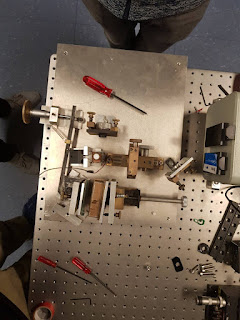Dye Laser part 5
What now?
I know that dye dies proportionally to pumping power levels, I also know that chlorophyll, like all dyes, has triplet level that "steals" possible molecules. First one rules out high pumping power densities, second rules out continuous wave pumping. Knowing that I can't really make it work in my workshop due to lack of any pulsed laser for pumping. Consequently I decided to again contact universities for help.
Act one - Warsaw University of Technology
I started by contacting my professor at Warsaw University of technology. He was very eager to try it out, he even found some old master's degree work of his student that was coumarin laser. Basic plan was to try aligning it first using well established laser dye and when system will be up and running then swap dye for chlorophyll.
 |
| laser resonator |
On the picture you can see laser, as left by master's student 10 years ago, just after cleaning. For pumping we used OPO pumped with 3rd harmonic of pulsed Nd:YAG laser. Output wavelength was tuned for maximum fluorescent response of rhodamine (around 532nm). Rough beam parameters are: few ns pulse, 1-10mJ of energy. We used OPO instead of using directly 2nd harmonic of laser mostly because OPO and 3rd harmonic generator were already installed and we didn't want to change that. Lower pulse energy wasn't a problem as we had to lower it anyway to not break cuvette.
Resonator is built out of 2 flat mirrors and diffraction grating. Diffraction grating's tuning range ended above rhodamine lasing region (as it was designed for blue emission of coumarin). Unfortunately we realized that only after 4h of trying to get it to work. That was first and only approach at WUT at the end of February. Till this day we were unable to organize any other meeting due to professor's load with student related activities.
Act two - Warsaw University
After few months of waiting I gave up the idea of powering up laser at WUT. I, again contacted people that let me measured lifetimes and to my surprise they invited me again to try to build laser.
I'm very grateful they want to spend their time with me and I'm unbelievably surprised that they are able to find more time to work on project with basically stranger than WUT for their student. I spent 2 days there with professor helping me when I struggled and not disturbing me when it was more educational for me to figure out things by myself.
Linear system
First setup I tried was in line pumped dye. Basic to dichroic mirror + cuvette setup. Setup seems simple but aligning it is more challenging than it seems at first. Laser resonators are aligned with shining outside laser beam through laser output. Problem is that this laser has 4 outputs. reflections from air-glass and glass-liquid transition on both ends of cuvette. Because I want to align one specific mode in resonator I need to somehow supress or differentiate 3 other reflections. I received perfect suggestion to put paper inside cuvette to block light from hitting the other end and also to pour IPA inside to decrease intensity of glass-liquid one.
With just one bright and one feint dot I was able to align on axis "output" beam with pumping beam. Next I introduced first, flat mirror and adjusted it until reflection matched "output" beam. Input mirror is double flat piece of glass with dichroic coating on one side. That means that light can also reflect from other end. As much as I wanted to believe they're perfectly parallel they aren't. Now I not only had to deal with faint dot generate by glass-liquid transition but also second one generate by reflection from glass-air transition in mirror.
After I had one mirror aligned it was time to start fighting with second one. Unfortunately at this point in time I need cuvette transparent so I had to remove paper. That double amount of reflections I had to deal with. Aligning second mirror is extremely hard due to it's curvature. The best I could do is to introduce iris in the "output" beam at the distance from the mirror that's equal to it's focal length. Not perfect but should provide coarse alignment.
 |
| laser setup |
On the right is HeNe laser, going though 2 mirrors in Z pattern to let me freely "manage" beam in all axis (one of the mirrors is covered with paper to help with alignment. In the middle at the top is iris used to differentiate original beam and skewed reflections. In the middle, in orange box is cuvette, tilted of axis to reflect light. Translation table contains concave mirror with kinematic mount. On the left comes pumping light.
Talking about pumping university didn't have ns Q-switched Nd:YAG but they had even better thing: 100ps Ti:sapphire laser. With around 2W of average power at second harmonic (400nm), 15khz pulse repetition it seems even better at pumping dye laser (especially as I won't have to listen to pump flashes for next few nights).
Unfortunately this topology has one inherent problem. Light path length * dye concentration is a tradeoff. Too small and there's not enough gain, too much and pumping light gets "dimmer" along the path making gain unequal.
perpendicular system
At some point I gave up trying to make my linear system work and instead switched to another, very popular variant - perpendicular pumping. It fixes main problem of linear pumping by separating pumping and lasing paths. pumping beam is expanded and then focused by cylindrical lens into thin line at the edge of cuvette.
Funny enough it worked just after aligning pumping beam! Unfortunately I tried increasing output power and consequently misaligned it. For next 2h I was searching for alignment again but couldn't find it.



Comments
Post a Comment